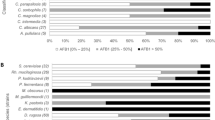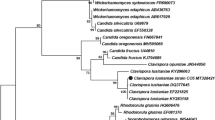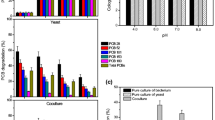Abstract
In order to assess the role of yeasts in the natural detoxification process of sediments polluted with biaryl compounds, indigenous yeast species able to degrade biphenyl (BP) were isolated and identified. The degradation ability of 24 strains of the genera Candida spp., Cryptococcus spp., Pichia spp., Rhodotorula spp., Trichosporon spp. and Yarrowia spp. was evaluated by the identification of the BP-metabolites, by HPLC analysis. 4-Hydroxybiphenyl was the main derivative in the Candida krusei, C. tenuis, C. tropicalis, Pichia haplophila, Rhodotorula glutinis, Trichosporon pullulans and Yarrowia lipolytica cultures. 3-Hydroxybiphenyl was detected in minor amounts in the culture supernatant of C. tropicalis, C. krusei strains and R. glutinis. Further hydroxylation led to 3,4-dihydroxy and 2,3-dihydroxybiphenyl; the former in C. tropicalis, C. krusei and R. glutinis cultures, and the latter only in the R. glutinis assays. The cleavage product 4-phenyl-2-pyrone-6-carboxylic acid, was observed in R. glutinis and Y. lipolytica cultures. The degradation ability of the R. glutinis isolates was noteworthy; as four hydrolxylated intermediates and a ring-cleavage product were obtained in both strain cultures. The species studied in this report were dominant in polluted sediments; furthermore, R. glutinis had been mentioned as able to degrade other aromatic hydrocarbons and had high relevance in bioremediation experiments.
Similar content being viewed by others
References
Abramowicz, D.A. 1990 Aerobic and anaerobic biodegradation of PCBs: a review. CRC Critical Review of Biotechnology 10, 241–251.
Barnett, J.A., Payne, R.W. & Yarrow, D. 1996 Yeast Identification PC program, version 4 — United Kingdon. ISBN 0–951–31488–2.
Cerniglia, C.E., Crow, S.A. 1981. Metabolism of aromatic hydrocarbons by yeasts. Archives of Microbiology 129, 9–13.
Chaudhry, G.R. & Chapalamadugu, S. 1991 Biodegradation of halogenated organic compounds. Microbiological Review 55, 59–79.
Hammer, E., Krowas, D., Schäfer, A., Specht, M., Francke, W. & Schauer, F. 1998 Isolation and characterization of a dibenzofuran degrading yeast: Identification of oxidation and ring cleavage products. Applied and Environmental Microbiology 64, 2215–2219.
Kreisel, H. & Schauer, F. 1987 Methoden des mykologischen Laboratoriums. Gustav Fischer, Verlag, Jena, Germany, pp. 1–38. ISBN 3–334–00123–7.
Kurtzman, C.P. & Fell, J.W. 1998 The Yeasts, a Taxonomic Study. Elsevier Science, 4th. ed. The Netherlands, pp. 1–1934 ISBN 0–444–81312–8.
Lange, J., Hammer, E., Specht, M., Francke, W. & Schauer, F. 1998 Biodegradation of biphenyl by the ascomycetous yeast Debaryomyces vanrijiae. Applied Microbiology and Biotechnology 50, 364–368.
Middelhoven, W.J. 1993 Catabolism of benzene compounds by ascomycetous and basidiomycetous yeasts and yeastlike fungi. Antonie van Leeuwenhoek 63, 125–144.
Mobley, D.P. 1994 Study of biphenyl hydroxylase activity in Aspergillusm parasitivus using a colorimetric assay. Applied Microbiology and Biotechnology 40, 622–628.
Mohn, W.W., Westerberg, K., Cullen, W.R. & Reimer, K.J. 1997 Aerobic biodegradation of BP and polychlorinated BP by Artic soil microorganisms. Applied and Environmental Microbiology 63, 3378–3384.
Oudin, P., Toth, J.A., Bonally, R. & Balogh, C. 1999 Quantitation of intracellular polychlorobiphenyls in growth of Rhodotorula glutinis. Biotechnology Techniques 13, 101–105.
Parkinson, A. & Safe, S. 1982 Cytochrome P-450 mediated metabolism of BP and the 4-halobiphenyls. Biochemical Pharmacology 31, 1849–1856.
Salvo, J.J., Mobley, D.P., Brown, D., Caruso, L., Yake, A., Spivack, J. & Dietrich, D.K. 1990 Biosynthesis of p-hydroxylated aromatics. Biotechnology Progress 6, 193–197.
Smith, V.P., Davis, P.J., Clark, A.M. & Glover-Milton, S. 1980 Hydroxylations of BP by fungi. Journal of Applied Bacteriology 49, 65–73.
Sondossi, M., Sylvestre, M. & Ahmad, D. 1992 Effects of chloro-benzoate transformation on the Pseudomonas testosteroni biphenyl and chloroBP degradation pathway. Applied and Environmental Microbiology 58, 485–495.
Wiseman, A., Gondal, J.A. & Sims, P. 1975 4′-Hydroxylation of biphenyl by yeasts containing cytochrome P-450; radiation and thermal stability, comparison with liver enzyme (oxidized and reduced forms). Biochemistry Society Transactions 3, 278–281.
Author information
Authors and Affiliations
Rights and permissions
About this article
Cite this article
Romero, M.C., Hammer, E., Cazau, M.C. et al. Selection of autochthonous yeast strains able to degrade biphenyl. World Journal of Microbiology and Biotechnology 17, 591–594 (2001). https://doi.org/10.1023/A:1012462906663
Issue Date:
DOI: https://doi.org/10.1023/A:1012462906663




